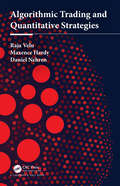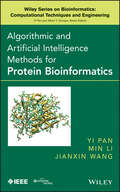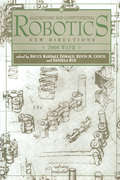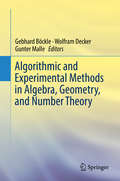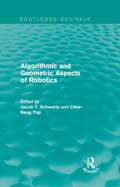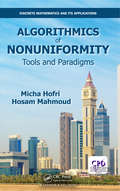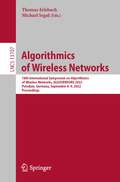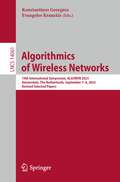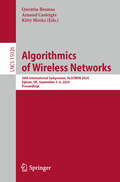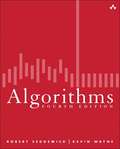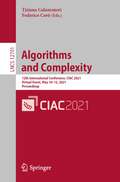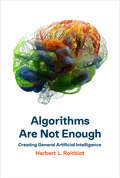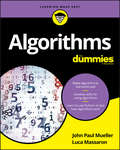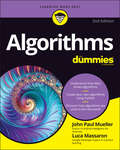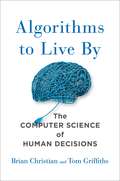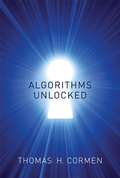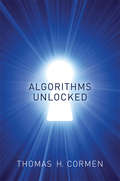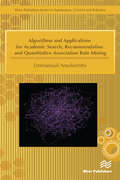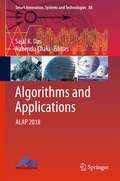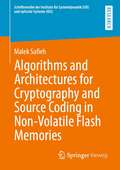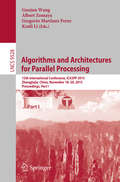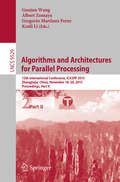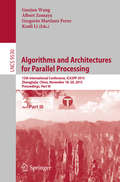- Table View
- List View
Algorithmic Trading and Quantitative Strategies
by Raja VeluAlgorithmic Trading and Quantitative Strategies provides an in-depth overview of this growing field with a unique mix of quantitative rigor and practitioner’s hands-on experience. The focus on empirical modeling and practical know-how makes this book a valuable resource for students and professionals. The book starts with the often overlooked context of why and how we trade via a detailed introduction to market structure and quantitative microstructure models. The authors then present the necessary quantitative toolbox including more advanced machine learning models needed to successfully operate in the field. They next discuss the subject of quantitative trading, alpha generation, active portfolio management and more recent topics like news and sentiment analytics. The last main topic of execution algorithms is covered in detail with emphasis on the state of the field and critical topics including the elusive concept of market impact. The book concludes with a discussion on the technology infrastructure necessary to implement algorithmic strategies in large-scale production settings. A git-hub repository includes data-sets and explanatory/exercise Jupyter notebooks. The exercises involve adding the correct code to solve the particular analysis/problem.
Algorithmic and Artificial Intelligence Methods for Protein Bioinformatics
by Min Li Jianxin Wang Yi PanAn in-depth look at the latest research, methods, and applications in the field of protein bioinformaticsThis book presents the latest developments in protein bioinformatics, introducing for the first time cutting-edge research results alongside novel algorithmic and AI methods for the analysis of protein data. In one complete, self-contained volume, Algorithmic and Artificial Intelligence Methods for Protein Bioinformatics addresses key challenges facing both computer scientists and biologists, arming readers with tools and techniques for analyzing and interpreting protein data and solving a variety of biological problems.Featuring a collection of authoritative articles by leaders in the field, this work focuses on the analysis of protein sequences, structures, and interaction networks using both traditional algorithms and AI methods. It also examines, in great detail, data preparation, simulation, experiments, evaluation methods, and applications. Algorithmic and Artificial Intelligence Methods for Protein Bioinformatics:Highlights protein analysis applications such as protein-related drug activity comparisonIncorporates salient case studies illustrating how to apply the methods outlined in the bookTackles the complex relationship between proteins from a systems biology point of viewRelates the topic to other emerging technologies such as data mining and visualizationIncludes many tables and illustrations demonstrating concepts and performance figuresAlgorithmic and Artificial Intelligence Methods for Protein Bioinformatics is an essential reference for bioinformatics specialists in research and industry, and for anyone wishing to better understand the rich field of protein bioinformatics.
Algorithmic and Computational Robotics: New Directions 2000 WAFR
by Daniela Rus Bruce Randall Donald Kevin M. LynchAlgorithms that control the computational processes relating sensors and actuators are indispensable for robot navigation and the perception of the world in which they move. Therefore, a deep understanding of how algorithms work to achieve this control is essential for the development of efficient and usable robots in a broad field of applications.
Algorithmic and Experimental Methods in Algebra, Geometry, and Number Theory
by Wolfram Decker Gebhard Böckle Gunter Malle<P>This book presents state-of-the-art research and survey articles that highlight work done within the Priority Program SPP 1489 “Algorithmic and Experimental Methods in Algebra, Geometry and Number Theory”, which was established and generously supported by the German Research Foundation (DFG) from 2010 to 2016. The goal of the program was to substantially advance algorithmic and experimental methods in the aforementioned disciplines, to combine the different methods where necessary, and to apply them to central questions in theory and practice. Of particular concern was the further development of freely available open source computer algebra systems and their interaction in order to create powerful new computational tools that transcend the boundaries of the individual disciplines involved. <P> The book covers a broad range of topics addressing the design and theoretical foundations, implementation and the successful application of algebraic algorithms in order to solve mathematical research problems. <P> It offers a valuable resource for all researchers, from graduate students through established experts, who are interested in the computational aspects of algebra, geometry, and/or number theory.
Algorithmic and Geometric Aspects of Robotics (Routledge Revivals)
by Jacob T. Schwartz Chee-Keng YapFirst published in 1987, the seven chapters that comprise this book review contemporary work on the geometric side of robotics. The first chapter defines the fundamental goal of robotics in very broad terms and outlines a research agenda each of whose items constitutes a substantial area for further research. The second chapter presents recently developed techniques that have begun to address the geometric side of this research agenda and the third reviews several applied geometric ideas central to contemporary work on the problem of motion planning. The use of Voronoi diagrams, a theme opened in these chapters, is explored further later in the book. The fourth chapter develops a theme in computational geometry having obvious significance for the simplification of practical robotics problems — the approximation or decomposition of complex geometric objects into simple ones. The final chapters treat two examples of a class of geometric ‘reconstruction’ problem that have immediate application to computer-aided geometric design systems.
Algorithmic and High-Frequency Trading
by Álvaro Cartea Sebastian Jaimungal José PenalvaThe design of trading algorithms requires sophisticated mathematical models backed up by reliable data. <P><P> In this textbook, the authors develop models for algorithmic trading in contexts such as executing large orders, market making, targeting VWAP and other schedules, trading pairs or collection of assets, and executing in dark pools. These models are grounded on how the exchanges work, whether the algorithm is trading with better informed traders (adverse selection), and the type of information available to market participants at both ultra-high and low frequency. Algorithmic and High-Frequency Trading is the first book that combines sophisticated mathematical modelling, empirical facts and financial economics, taking the reader from basic ideas to cutting-edge research and practice. If you need to understand how modern electronic markets operate, what information provides a trading edge, and how other market participants may affect the profitability of the algorithms, then this is the book for you.
Algorithmics of Nonuniformity: Tools and Paradigms (Discrete Mathematics and Its Applications)
by Micha Hofri Hosam MahmoudAlgorithmics of Nonuniformity is a solid presentation about the analysis of algorithms, and the data structures that support them. Traditionally, algorithmics have been approached either via a probabilistic view or an analytic approach. The authors adopt both approaches and bring them together to get the best of both worlds and benefit from the advantage of each approach. The text examines algorithms that are designed to handle general data—sort any array, find the median of any numerical set, and identify patterns in any setting. At the same time, it evaluates "average" performance, "typical" behavior, or in mathematical terms, the expectations of the random variables that describe their operations. Many exercises are presented, which are essential since they convey additional material complementing the content of the chapters. For this reason, the solutions are more than mere answers, but explain and expand upon related concepts, and motivate further work by the reader. Highlights: A unique book that merges probability with analysis of algorithms Approaches analysis of algorithms from the angle of uniformity Non-uniformity makes more realistic models of real-life scenarios possible Results can be applied to many applications Includes many exercises of various levels of difficulty About the Authors: Micha Hofri is a Professor of Computer Science, and former department head at Worcester Polytechnic Institute. He holds a Ph.D. of Industrial Engineering (1972), all from Technion, the Israel Institute of Technology. He has 39 publications in Mathematics. Hosam Mahmoud is a Professor at, the Department of Statistics at George Washington University in Washington D.C., where he used to be the former chair. He holds an Ph.D. in Computer Science from Ohio State University. He is on the editorial board of five academic journals.
Algorithmics of Wireless Networks: 18th International Symposium on Algorithmics of Wireless Networks, ALGOSENSORS 2022, Potsdam, Germany, September 8–9, 2022, Proceedings (Lecture Notes in Computer Science #13707)
by Thomas Erlebach Michael SegalThis book constitutes the refereed proceedings of the 18th International Symposium on Algorithmics of Wireless Network, ALGOSENSORS 2022, which took place in Potsdam, Germany in September 2022.The 10 full papers presented in this volume were carefully reviewed and selected from 21 submissions. ALGOSENSORS is an international symposium dedicated to algorithmic aspects of wireless networks.
Algorithmics of Wireless Networks: 19th International Symposium, ALGOWIN 2023, Amsterdam, The Netherlands, September 7–8, 2023, Revised Selected Papers (Lecture Notes in Computer Science #14061)
by Evangelos Kranakis Konstantinos GeorgiouThis book constitutes the refereed proceedings of the 19th International Symposium on Algorithmics of Wireless Networks, ALGOWIN 2023, held in Amsterdam, The Netherlands, during September 7–8, 2023.The 10 full papers included in this book were carefully reviewed and selected from 22 submissions. They were organized in topical sections as follows: design and analysis of algorithms, models of computation and experimental analysis.
Algorithmics of Wireless Networks: 20th International Symposium, ALGOWIN 2024, Egham, UK, September 5–6, 2024, Proceedings (Lecture Notes in Computer Science #15026)
by Kitty Meeks Quentin Bramas Arnaud CasteigtsThis book constitutes the refereed proceedings of the 20th International Symposium on Algorithmics of Wireless Networks, ALGOWIN 2024, held in Egham, UK, in September 2024. The 14 full papers presented here were carefully reviewed and selected from 26 submissions. These papers focus on the Algorithmic aspects of Wireless networks, including the design and analysis of Algorithms, Models of computation and Experimental analysis, involved in various types of computational entities.
Algorithms
by Robert Sedgewick Kevin WayneThis fourth edition of Robert Sedgewick and Kevin Wayne's Algorithms is the leading textbook on algorithms today and is widely used in colleges and universities worldwide. This book surveys the most important computer algorithms currently in use and provides a full treatment of data structures and algorithms for sorting, searching, graph processing, and string processing--including fifty algorithms every programmer should know. In this edition, new Java implementations are written in an accessible modular programming style, where all of the code is exposed to the reader and ready to use. <p><p> The algorithms in this book represent a body of knowledge developed over the last 50 years that has become indispensable, not just for professional programmers and computer science students but for any student with interests in science, mathematics, and engineering, not to mention students who use computation in the liberal arts.
Algorithms and Complexity: 12th International Conference, CIAC 2021, Virtual Event, May 10–12, 2021, Proceedings (Lecture Notes in Computer Science #12701)
by Tiziana Calamoneri Federico CoròThis book constitutes the refereed conference proceedings of the 12th International Conference on Algorithms and Complexity, CIAC 2019, held as a virtual event, in May 2021. The 28 full papers presented together with one invited lecture and 2 two abstracts of invited lectures were carefully reviewed and selected from 78 submissions. The International Conference on Algorithms and Complexity is intended to provide a forum for researchers working in all aspects of computational complexity and the use, design, analysis and experimentation of efficient algorithms and data structures. The papers present original research in the theory and applications of algorithms and computational complexity.Due to the Corona pandemic the conference was held virtually.
Algorithms Are Not Enough: Creating General Artificial Intelligence
by Herbert L. RoitblatWhy a new approach is needed in the quest for general artificial intelligence.Since the inception of artificial intelligence, we have been warned about the imminent arrival of computational systems that can replicate human thought processes. Before we know it, computers will become so intelligent that humans will be lucky to kept as pets. And yet, although artificial intelligence has become increasingly sophisticated--with such achievements as driverless cars and humanless chess-playing--computer science has not yet created general artificial intelligence. In Algorithms Are Not Enough, Herbert Roitblat explains how artificial general intelligence may be possible and why a robopocalypse is neither imminent, nor likely.
Algorithms For Dummies
by John Paul Mueller Luca MassaronDiscover how algorithms shape and impact our digital world All data, big or small, starts with algorithms. Algorithms are mathematical equations that determine what we see—based on our likes, dislikes, queries, views, interests, relationships, and more—online. They are, in a sense, the electronic gatekeepers to our digital, as well as our physical, world. This book demystifies the subject of algorithms so you can understand how important they are business and scientific decision making. Algorithms for Dummies is a clear and concise primer for everyday people who are interested in algorithms and how they impact our digital lives. Based on the fact that we already live in a world where algorithms are behind most of the technology we use, this book offers eye-opening information on the pervasiveness and importance of this mathematical science—how it plays out in our everyday digestion of news and entertainment, as well as in its influence on our social interactions and consumerism. Readers even learn how to program an algorithm using Python! Become well-versed in the major areas comprising algorithms Examine the incredible history behind algorithms Get familiar with real-world applications of problem-solving procedures Experience hands-on development of an algorithm from start to finish with Python If you have a nagging curiosity about why an ad for that hammock you checked out on Amazon is appearing on your Facebook page, you'll find Algorithm for Dummies to be an enlightening introduction to this integral realm of math, science, and business.
Algorithms For Dummies
by John Paul Mueller Luca MassaronYour secret weapon to understanding—and using!—one of the most powerful influences in the world today From your Facebook News Feed to your most recent insurance premiums—even making toast!—algorithms play a role in virtually everything that happens in modern society and in your personal life. And while they can seem complicated from a distance, the reality is that, with a little help, anyone can understand—and even use—these powerful problem-solving tools! In Algorithms For Dummies, you'll discover the basics of algorithms, including what they are, how they work, where you can find them (spoiler alert: everywhere!), who invented the most important ones in use today (a Greek philosopher is involved), and how to create them yourself. You'll also find: Dozens of graphs and charts that help you understand the inner workings of algorithms Links to an online repository called GitHub for constant access to updated code Step-by-step instructions on how to use Google Colaboratory, a zero-setup coding environment that runs right from your browser Whether you're a curious internet user wondering how Google seems to always know the right answer to your question or a beginning computer science student looking for a head start on your next class, Algorithms For Dummies is the can't-miss resource you've been waiting for.
Algorithms To Live By: What Computers Can Teach Us About Solving Human Problems
by Brian Christian Tom GriffithsA fascinating exploration of how insights from computer algorithms can be applied to our everyday lives, helping to solve common decision-making problems and illuminate the workings of the human mind All our lives are constrained by limited space and time, limits that give rise to a particular set of problems. What should we do, or leave undone, in a day or a lifetime? How much messiness should we accept? What balance of new activities and familiar favorites is the most fulfilling? These may seem like uniquely human quandaries, but they are not: computers, too, face the same constraints, so computer scientists have been grappling with their version of such issues for decades. And the solutions they've found have much to teach us. In a dazzlingly interdisciplinary work, acclaimed author Brian Christian and cognitive scientist Tom Griffiths show how the algorithms used by computers can also untangle very human questions. They explain how to have better hunches and when to leave things to chance, how to deal with overwhelming choices and how best to connect with others. From finding a spouse to finding a parking spot, from organizing one's inbox to understanding the workings of memory, Algorithms to Live By transforms the wisdom of computer science into strategies for human living.
Algorithms Unlocked
by Thomas H. CormenHave you ever wondered how your GPS can find the fastest way to your destination, selecting one route from seemingly countless possibilities in mere seconds? How your credit card account number is protected when you make a purchase over the Internet? The answer is algorithms. And how do these mathematical formulations translate themselves into your GPS, your laptop, or your smart phone? This book offers an engagingly written guide to the basics of computer algorithms. In Algorithms Unlocked, Thomas Cormen -- coauthor of the leading college textbook on the subject -- provides a general explanation, with limited mathematics, of how algorithms enable computers to solve problems. Readers will learn what computer algorithms are, how to describe them, and how to evaluate them. They will discover simple ways to search for information in a computer; methods for rearranging information in a computer into a prescribed order ("sorting"); how to solve basic problems that can be modeled in a computer with a mathematical structure called a "graph" (useful for modeling road networks, dependencies among tasks, and financial relationships); how to solve problems that ask questions about strings of characters such as DNA structures; the basic principles behind cryptography; fundamentals of data compression; and even that there are some problems that no one has figured out how to solve on a computer in a reasonable amount of time.
Algorithms Unlocked
by Thomas H. CormenFor anyone who has ever wondered how computers solve problems, an engagingly written guide for nonexperts to the basics of computer algorithms.Have you ever wondered how your GPS can find the fastest way to your destination, selecting one route from seemingly countless possibilities in mere seconds? How your credit card account number is protected when you make a purchase over the Internet? The answer is algorithms. And how do these mathematical formulations translate themselves into your GPS, your laptop, or your smart phone? This book offers an engagingly written guide to the basics of computer algorithms. In Algorithms Unlocked, Thomas Cormen—coauthor of the leading college textbook on the subject—provides a general explanation, with limited mathematics, of how algorithms enable computers to solve problems.Readers will learn what computer algorithms are, how to describe them, and how to evaluate them. They will discover simple ways to search for information in a computer; methods for rearranging information in a computer into a prescribed order (“sorting”); how to solve basic problems that can be modeled in a computer with a mathematical structure called a “graph” (useful for modeling road networks, dependencies among tasks, and financial relationships); how to solve problems that ask questions about strings of characters such as DNA structures; the basic principles behind cryptography; fundamentals of data compression; and even that there are some problems that no one has figured out how to solve on a computer in a reasonable amount of time.
Algorithms and Applications for Academic Search, Recommendation and Quantitative Association Rule Mining (River Publishers Series In Automation, Control And Robotics Ser.)
by Emmanouil AmolochitisAlgorithms and Applications for Academic Search, Recommendation and Quantitative Association Rule Mining presents novel algorithms for academic search, recommendation and association rule mining that have been developed and optimized for different commercial as well as academic purpose systems. Along with the design and implementation of algorithms, a major part of the work presented in the book involves the development of new systems both for commercial as well as for academic use. In the first part of the book the author introduces a novel hierarchical heuristic scheme for re-ranking academic publications retrieved from standard digital libraries. The scheme is based on the hierarchical combination of a custom implementation of the term frequency heuristic, a time-depreciated citation score and a graph-theoretic computed score that relates the paper's index terms with each other. In order to evaluate the performance of the introduced algorithms, a meta-search engine has been designed and developed that submits user queries to standard digital repositories of academic publications and re-ranks the top-n results using the introduced hierarchical heuristic scheme. In the second part of the book the design of novel recommendation algorithms with application in different types of e-commerce systems are described. The newly introduced algorithms are a part of a developed Movie Recommendation system, the first such system to be commercially deployed in Greece by a major Triple Play services provider. The initial version of the system uses a novel hybrid recommender (user, item and content based) and provides daily recommendations to all active subscribers of the provider (currently more than 30,000). The recommenders that we are presenting are hybrid by nature, using an ensemble configuration of different content, user as well as item-based recommenders in order to provide more accurate recommendation results. The final part of the book presents the design of a quantitative association rule mining algorithm. Quantitative association rules refer to a special type of association rules of the form that antecedent implies consequent consisting of a set of numerical or quantitative attributes. The introduced mining algorithm processes a specific number of user histories in order to generate a set of association rules with a minimally required support and confidence value. The generated rules show strong relationships that exist between the consequent and the antecedent of each rule, representing different items that have been consumed at specific price levels. This research book will be of appeal to researchers, graduate students, professionals, engineers and computer programmers.
Algorithms and Applications: Alap 2018 (Smart Innovation, Systems And Technologies #88)
by Nabendu Chaki Sajal K. DasThis book presents the proceedings of the Conference on Algorithms and Applications (ALAP 2018), which focuses on various areas of computing, like distributed systems and security, big data and analytics and very-large-scale integration (VLSI) design. The book provides solutions to a broad class of problems in diverse areas of algorithms in our daily lives in a world designed for, and increasingly controlled by algorithms. Written by eminent personalities from academia and industry, the papers included offer insights from a number of perspectives, providing an overview of the state of the art in the field. The book consists of invited talks by respected speakers, papers presented in technical sessions, and tutorials to offer ideas, results, work-in-progress and experiences of various algorithmic aspects of computational science and engineering.
Algorithms and Architectures for Cryptography and Source Coding in Non-Volatile Flash Memories (Schriftenreihe der Institute für Systemdynamik (ISD) und optische Systeme (IOS))
by Malek SafiehIn this work, algorithms and architectures for cryptography and source coding are developed, which are suitable for many resource-constrained embedded systems such as non-volatile flash memories. A new concept for elliptic curve cryptography is presented, which uses an arithmetic over Gaussian integers. Gaussian integers are a subset of the complex numbers with integers as real and imaginary parts. Ordinary modular arithmetic over Gaussian integers is computational expensive. To reduce the complexity, a new arithmetic based on the Montgomery reduction is presented. For the elliptic curve point multiplication, this arithmetic over Gaussian integers improves the computational efficiency, the resistance against side channel attacks, and reduces the memory requirements. Furthermore, an efficient variant of the Lempel-Ziv-Welch (LZW) algorithm for universal lossless data compression is investigated. Instead of one LZW dictionary, this algorithm applies several dictionaries to speed up the encoding process. Two dictionary partitioning techniques are introduced that improve the compression rate and reduce the memory size of this parallel dictionary LZW algorithm.
Algorithms and Architectures for Parallel Processing: 15th International Conference, ICA3PP 2015, Zhangjiajie, China, November 18-20, 2015, Proceedings, Part I (Lecture Notes in Computer Science #9528)
by Albert Zomaya Guojun Wang Gregorio Martinez Perez Kenli LiThis fourvolume set LNCS 9528, 9529, 9530 and 9531 constitutes the refereed proceedingsof the 15th International Conference on Algorithms and Architectures for ParallelProcessing, ICA3PP 2015, held in Zhangjiajie, China, in November 2015. The 219revised full papers presented together with 77 workshop papers in these fourvolumes were carefully reviewed and selected from 807 submissions (602 fullpapers and 205 workshop papers). The first volume comprises the followingtopics: parallel and distributed architectures; distributed and network-basedcomputing and internet of things and cyber-physical-social computing. Thesecond volume comprises topics such as big data and its applications andparallel and distributed algorithms. The topics of the third volume are:applications of parallel and distributed computing and service dependabilityand security in distributed and parallel systems. The covered topics of the fourthvolume are: software systems and programming models and performance modelingand evaluation.
Algorithms and Architectures for Parallel Processing: 15th International Conference, ICA3PP 2015, Zhangjiajie, China, November 18-20, 2015, Proceedings, Part II (Lecture Notes in Computer Science #9529)
by Albert Zomaya Guojun Wang Gregorio Martinez Perez Kenli LiThis book constitutes the refereed proceedings of the Workshops and Symposiums of the 15th International Conference on Algorithms and Architectures for Parallel Processing, ICA3PP 2015, held in Zhangjiajie, China, in November 2015.<P><P> The program of this year consists of 6 symposiums/workshops that cover a wide range of research topics on parallel processing technology: the Sixth International Workshop on Trust, Security and Privacy for Big Data, TrustData 2015; the Fifth International Symposium on Trust, Security and Privacy for Emerging Applications, TSP 2015; the Third International Workshop on Network Optimization and Performance Evaluation, NOPE 2015; the Second International Symposium on Sensor-Cloud Systems, SCS 2015; the Second International Workshop on Security and Privacy Protection in Computer and Network Systems, SPPCN 2015; and the First International Symposium on Dependability in Sensor, Cloud, and Big Data Systems and Applications, DependSys 2015.<P> The aim of these symposiums/workshops is to provide a forum to bring together practitioners and researchers from academia and industry for discussion and presentations on the current research and future directions related to parallel processing technology. The themes and topics of these symposiums/workshops are a valuable complement to the overall scope of ICA3PP 2015 and give additional values and interests.
Algorithms and Architectures for Parallel Processing: 15th International Conference, ICA3PP 2015, Zhangjiajie, China, November 18-20, 2015, Proceedings, Part III (Lecture Notes in Computer Science #9530)
by Albert Zomaya Guojun Wang Gregorio Martinez Perez Kenli LiThis four volume set LNCS 9528, 9529, 9530 and 9531 constitutes the refereed proceedings of the 15th International Conference on Algorithms and Architectures for Parallel Processing, ICA3PP 2015, held in Zhangjiajie, China, in November 2015.<P><P> The 219 revised full papers presented together with 77 workshop papers in these four volumes were carefully reviewed and selected from 807 submissions (602 full papers and 205 workshop papers). The first volume comprises the following topics: parallel and distributed architectures; distributed and network-based computing and internet of things and cyber-physical-social computing. The second volume comprises topics such as big data and its applications and parallel and distributed algorithms. The topics of the third volume are: applications of parallel and distributed computing and service dependability and security in distributed and parallel systems. The covered topics of the fourth volume are: software systems and programming models and performance modeling and evaluation.
